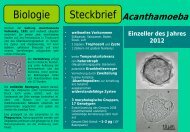Paramecium - Deutsche Gesellschaft für Protozoologie / German ...
Paramecium - Deutsche Gesellschaft für Protozoologie / German ...
Paramecium - Deutsche Gesellschaft für Protozoologie / German ...
You also want an ePaper? Increase the reach of your titles
YUMPU automatically turns print PDFs into web optimized ePapers that Google loves.
Some interesting new ciliates from the microaerobic and<br />
anaerobic bottom of the Gotlandtief (220 m below NN),<br />
Baltic Sea<br />
Wilhelm Foissner 1 , Klaus Jürgens 2<br />
1 Universität Salzburg, Organismische Biologie<br />
2 Baltic Sea Research Institute Warnemünde<br />
Few data are available on ciliates from deep marine environments.<br />
Thus, we investigated the so-called Gotland depth in the Baltic Sea.<br />
Samples were taken from microaerobic and anaerobic sites close<br />
above the bottom at a depth of about 220 m. Ciliates were studied in<br />
vivo and after silver impregnation. We found about 20 species, most<br />
belonging to the haptorids, prostomatids, and scuticociliatids, some of<br />
which have an outstanding morphology and likely represent new<br />
genera and species. Obviously, deep marine environments are a<br />
further, almost untouched diversity pool, such as floodplain soils and<br />
tanks of bromeliads. Studying ciliates from deep marine environments<br />
poses two major problems: their abundance is usually very low<br />
and they cannot be cultivated with ordinary laboratory conditions.<br />
The poster shows three likely undescribed species, viz. a Metacystis<br />
(Haptoria ?) with several caudal cilia, a Plagiocampa-like prostomatid<br />
with large cortical alveoli, and a Holophrya-like prostomatid<br />
with a specific brush pattern. (Supported by FWF, P-19699-B17.)<br />
wilhelm.foissner@sbg.ac.at<br />
klaus.juergens@io-warnemuende.de<br />
57





